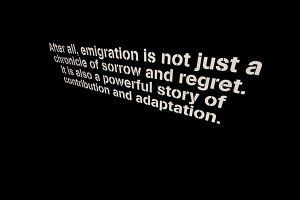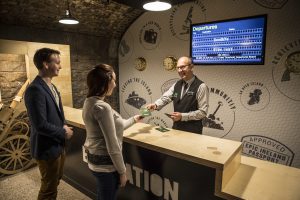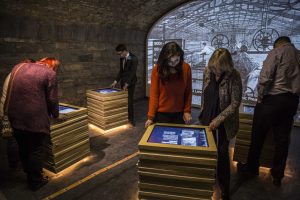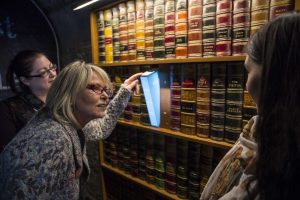MUSEUM EYE: EPIC Ireland
Published in Issue 5 (September/October 2016), Reviews, Volume 24CHQ Building, Custom House Quay, Dublin 1
info@epicirelandchq.com, +353 (0)1 5313688
By Tony Canavan

Above: Above all this is a celebration of how the Irish thrived (and thrive) in the world.

Above: The visitor receives a green ‘passport’ to be stamped in each gallery, giving you a tangible record of your visit.

Above: Every gallery has screens on the walls and floors, and audiovisual pods where visitors can swipe, click and touch to access information.

Above: Look out for the library, where you can pull out books and hear their contents. I have to admit that I was a bit baffled by some of this, but there are plenty of staff on hand to give advice and answer questions.
The building itself is historic. An eighteenth-century warehouse, it was a thriving centre of commerce and witness to some historical events, such as the huge banquet for thousands of soldiers returning from the Crimean War in 1856. CHL Consulting, the company that operates the Titanic Belfast attraction, is designer and operator of EPIC Ireland, which is probably the first digital-only museum in the world. Its collection is stored in the cloud rather than in rooms or behind glass, although there are some artefacts. There are 21 galleries, covering 21 different themes. As part of the bigger picture, it uses actors and film footage to tell the story of 320 members of the Irish diaspora, 70 of whom are still living. The displays explore why people left Ireland, the influence they have had abroad in the arts, science, education, sport and politics, and what Irish communities around the world look like today.
The visitor receives a green ‘passport’ to be stamped in each gallery, giving you a tangible record of your visit. Every gallery has screens on the walls and floors, and audiovisual pods where visitors can swipe, click and touch to access information. Look out for the library, where you can pull out books and hear their contents. I have to admit that I was a bit baffled by some of this, but there are plenty of staff on hand to give advice and answer questions.
I did not expect much before coming here but I spent over two hours in EPIC Ireland, not just swiping and tapping screens but actually following the stories told here. And this is the key to the centre’s success: it tells the individual stories of so many people. In the early galleries a long swathe of Irish history is covered, beginning with the introduction of Christianity; centuries of warfare, oppression and famine are conveyed, explaining why so many Irish people left these shores. The mood changes, however, in subsequent galleries, which follow the stories of what became of these exiles and emigrants.
Many famous people whose Irishness is well known feature, such as Grace Kelly, John F. Kennedy, Maureen O’Sullivan and Barack Obama, and also famous people whose Irish ancestry may not be widely recognised—from the Argentinian revolutionary Che Guevara (whose ancestors came from County Galway in the early eighteenth century) to Charles de Gaulle.
Reflecting the reality of history and the availability of information, only a quarter of the profiles featured are female, but many of these have remarkable stories to tell. For example, nineteenth-century journalist Nellie Bly, born Elizabeth Cochran Seaman in Pennsylvania to Irish parents, went undercover in a sweatshop to expose the harsh working conditions, and later as a psychiatric patient to find out what was really going on in the Blackwell Island insane asylum in New York. Another remarkable story is that of Ann Bonny, who became a pirate in the eighteenth century.
The most moving stories, however, are those of ordinary men and women, from earliest times to the present, who left Ireland to find new lives across the world, in North and South America, in Australia and New Zealand. Why they left and how they fared is the essence of the exhibition.
Above all this is a celebration of how the Irish thrived (and thrive) in the world. The galleries devoted to sport, science, literature and so on celebrate Irish successes and show how the Irish have influenced the world. One remarkable photograph shows hurley players in Argentina, where the sport was popular until the outbreak of World War I. The achievements of Irish men and women in science is another little-known area that is explored in another gallery.
As well as this, a cheer is raised for the Irish pub (tipping the hat to whiskey and Guinness along the way), Irish food (from potato bread to the 99 ice-cream cone), and of course music and dance, not forgetting the world-conquering Riverdance. The recreation of the Irish pub is particularly evocative, with information provided on the tabletops, videos of music sessions and interactive screens where the visitors can test their knowledge of whiskey and wine. I was surprised that so many vineyards in south-west France can trace their origin to Irish families.
The final part of the exhibition brings it bang up to date with the diaspora today, featuring blogs, tweets, social-media posts and emails from Irish people living abroad.
Tony Canavan is editor of Books Ireland.
















